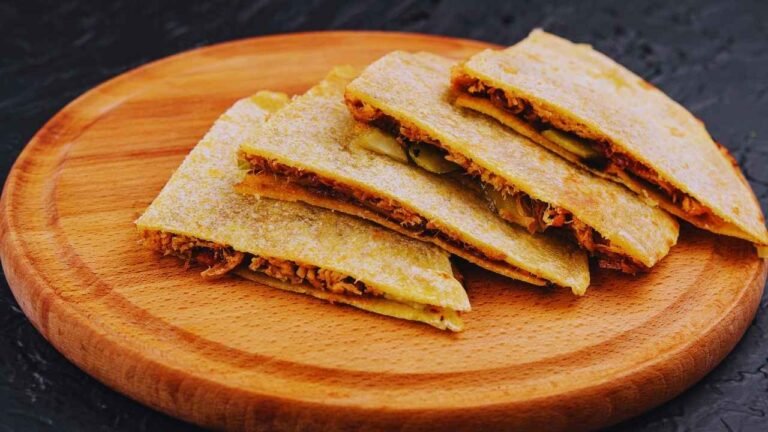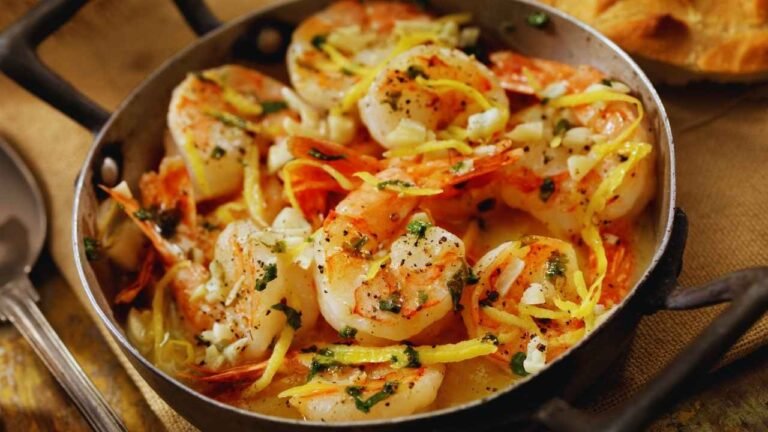Shrimp Stir Fry Recipe: A Quick and Flavorful Seafood Delight
Hello, friends. I am Olivia Rose Carter, and I’m excited to share my all-time favorite weekday dish: shrimp stir fry. This recipe is perfect for a satisfying, quick, and healthy meal. Stir-fries are a great option when you need to get dinner on the table quickly, as you can add whatever veggies you have on hand, and the shrimp cooks in a matter of minutes.
How I Fell in Love with Shrimp Stir Fry
Since I’ve always enjoyed seafood, I usually keep shrimp in my freezer for easy dinners. I recall my first attempt at making shrimp stir fry; it was one of those days when I was pressed for time but wanted to make something tasty and fresh. I took a few veggies and frozen shrimp from the refrigerator and threw them all into a heated pan. I had a restaurant-caliber dinner in about twenty minutes, and it made me question why I hadn’t done stir fry more frequently!
My go-to recipe these days is shrimp stir fry, and I can’t wait to share my version with you.

Why You’ll Love This Recipe
- Quick and Easy: This dish takes less than 20 minutes to prepare from beginning to end, making it the ideal choice for hectic weeknights.
- Healthy and Flavorful: Lean protein comes from shrimp, and you can add many fresh veggies to this recipe.
- Versatile: Feel free to replace the shrimp with chicken, beef, or tofu or change the veggies.
Shrimp Stir Fry Recipe: A Quick and Flavorful Seafood Delight
Course: MainCuisine: Asian-inspiredDifficulty: Easy4
servings10
minutes10
minutes350
kcalIngredients You’ll Need
Here’s what you’ll need for this simple and flavorful shrimp stir fry:
Ingredients
For the Stir Fry:
1 lb large shrimp (peeled and deveined)
2 tbsp. Vegetable oil (for stir-frying)
One red bell pepper (sliced)
One yellow bell pepper (sliced)
1 cup broccoli florets
One carrot (thinly sliced)
Two cloves garlic (minced)
1 tbsp. Fresh ginger (grated)
For the stir-fry sauce:
Add 3 tbsp of soy sauce (or tamari for a gluten-free option).
Add 1 tbsp of oyster sauce (optional, for extra depth).
Add 1 tbsp of honey or maple syrup for sweetness.
1 tsp. Sesame oil (for flavor)
One tablespoon rice vinegar (for tanginess)
1 tbsp cornstarch (mixed with 2 tbsp water for thickening)
- Optional Toppings:
Sliced green onions
Sesame seeds
Directions
- Make the Sauce: Combine the soy sauce, oyster sauce, honey, sesame oil, rice vinegar, and cornstarch slurry in a small basin. Put aside.
- Cook the Shrimp: Heat up one tablespoon of vegetable oil over medium-high heat in a big skillet or wok. When pink and opaque, add the shrimp and cook for two to three minutes on each side. After taking the shrimp out of the pan, put it aside.
- Stir Fry the Vegetables: Fill the pan with the last tablespoon of oil. Add the bell peppers, broccoli, carrots, garlic, and ginger. Stir-fry the veggies for 4–5 minutes or until they are crisp and tender.
- Combine: Return the cooked shrimp to the skillet. Toss the veggies and shrimp together after adding the stir-fry sauce. Stir-fry for another one to two minutes or until the sauce becomes thicker and evenly covers everything.
- Serve: Top your hot shrimp stir fry with sesame seeds and green onions if preferred.
Recipe Video
Instruments:
- Large skillet or wok
- A wooden spoon or spatula
- A small bowl for sauce mixing.
Common Problems and Solutions
Problem #1: Shrimp overcooks and becomes tough
- Solution: Monitor the shrimp closely as it cooks quickly. Once it turns pink and opaque, it’s done! Cooking shrimp for too long can make it rubbery.
Problem #2: Stir-fry sauce needs to be thicker.
- Solution: Confirm that the sauce is thickened by adding the cornstarch slurry. Simmer the sauce for an additional minute to get the appropriate thickness if it’s still too thin.
Problem #3: Vegetables are too soft.
- Solution: stir-fry them for a short while on high heat, just long enough to make them soft but not too crunchy. If you overcook them, they will get mushy.

U.S.-friendly ingredient substitutions
- Shrimp: For alternative variants, you may replace the shrimp with chicken, steak, or tofu.
- Vegetables: You may use whichever veggies you have on hand. This meal works wonderfully with zucchini, mushrooms, or snow peas.
- Soy Sauce: If you want a gluten-free substitute, try tamari or coconut aminos.
Frequently Asked Questions
- Can I use frozen shrimp for this recipe?
- Of course! To avoid too much moisture, ensure the shrimp are fully thawed and patted dry with paper towels before cooking.
- What should I serve with shrimp stir-fry?
- Perfect accompaniments for shrimp stir-fry are brown rice, noodles, or steaming rice. For a healthy alternative, you can also serve it over cauliflower rice or quinoa.
- Can I make this dish ahead of time?
- Yes, you may prepare the veggies and create the sauce in advance. Although stir fries are tastiest when eaten fresh, leftovers may be kept in the refrigerator for up to three days in an airtight container.
My Experience: Tips for the Perfect Shrimp Stir Fry
One of the challenges I faced when I started making stir-fry was time management. Since stir-frying is a speedy procedure, preparing and preparing all of your ingredients before you begin is critical. In this manner, you may avoid rushing to cut veggies in the middle of frying shrimp.
Another thing I’ve learned is to stir fry on high heat. As a result, the veggies cook more rapidly without losing their color or texture. It enhances the taste of the shrimp and gives it a lovely sear.
Conclusion
A tasty and easy dish is shrimp stir fry. This dish is ideal when you’re looking for a quick and filling midweek supper. This dish is flexible; you can use any vegetable or protein, whatever you have, and it will always turn out great.
Try this recipe and report back to me on how it worked out! It has become a favorite in my kitchen, but I’m confident it will do the same in yours.
Until next time,
Olivia Rose Carter
Frequently Asked Questions
Can I substitute shrimp with other proteins like chicken or tofu in this stir fry?
Indeed, you may easily replace shrimp with different proteins, such as tofu, beef, or chicken. Simply modify the cooking time to account for the fact that meat and chicken require more time to cook than shrimp.
What is the best way to prevent shrimp from becoming tough or overcooked?
Shrimp should only be cooked for 2-3 minutes on each side, or until they turn pink and opaque, to avoid overcooking or toughness. As soon as they are finished, take them off the heat to prevent a rubbery texture.
How can I make the stir-fry sauce thicker if it turns out too watery?
Make sure to add the cornstarch slurry (cornstarch combined with water) and simmer the sauce for an additional minute to thicken the stir-fry sauce. You can boil it a little longer to get the right consistency if it’s still too thin.








